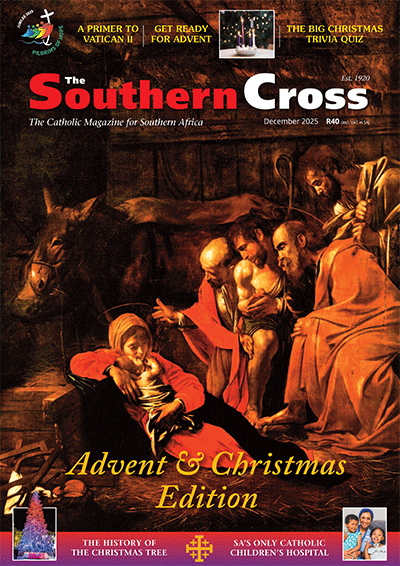The work of SA Church is a story worth reading
A STORY WORTH TELLING: Essays in Honour of Cardinal Napier, edited by Stuart C Bate OMI and Anthony Egan SJ. SACBC, Pretoria (2013). 391pp.
Reviewed by Claire Mathieson
 Reading A Story Worth Telling is like taking a tour through the passages of Khanya House, the Pretoria headquarters of the Southern African Catholic Bishops’ Conference, and being given a formal presentation on the work that the local Church does.
Reading A Story Worth Telling is like taking a tour through the passages of Khanya House, the Pretoria headquarters of the Southern African Catholic Bishops’ Conference, and being given a formal presentation on the work that the local Church does.
One may be overwhelmed, surprised even, by the far-reaching work the Church is doing in Southern Africa. For Catholics especially, it is information worth knowing hence the appropriate name of the book.
The book is a collection of essays from a wide array of authors, edited by Frs Stuart Bate OMI and Anthony Egan SJ. It provides a comprehensive breakdown on just how important the Church’s contribution to South Africa’s society is.
The voices of no less than nine bishops are heard, but A Story Worth Telling also gives a feel for the action on the coalface through the contribution of the many lay personalities who help to fulfil the Church’s pastoral mission.
With different authors, the book changes in flow and tone, style and subject. It is divided into three parts: evangelisation, justice and peace, and education. One can pick up the book and read from any point.
A Story Worth Telling is dedicated to the regions longest-serving bishop, Cardinal Wilfrid Napier of Durban.
It was in 2012 that Cardinal Napier of Durban celebrated a series of milestones: his 70th birthday, 50 years a Franciscan, and ten years a cardinal (as well as 41 years a priest). The book was suggested by Archbishop Buti Tlhagale of Johannesburg as a way of recognising not only the contribution which the cardinal has made to the Southern African Church, but also to show how the Church has grown during the cardinal’s time as a bishop.
For many South African Catholics, the essays may be something of an eye opener, especially if they are not familiar with the work of the SACBC.
For those already familiar with its work, this book may serve as a source of reference much of the information is not easily found online and some of the stories shared are personal accounts not found anywhere else, other than from the authors themselves.
Predictably, the quality of the writing varies. Some of the essays read like end-of-year reports for donors but in a way, that’s just what this should be. The faithful should know exactly what the Church is doing with their contributions and how the People of God are helping to make a difference through their giving.
Such essays might be tiring to read, but the information they convey will certainly boost the Catholic reader’s arsenal of positive facts about the Church’s works. Other essays succeed better in communicating a real sense of love and devotion behind the projects.
Thanks to the books structure, readers can choose chapters according to their mood and consume their SACBC information in bite-sized chunks some of which will require more chewing than others.
The second part of the book, entitled A story of justice, peace, development and integrity of creation in our world, will leave the Catholic reader feeling proud of the positive contribution the Church is making in South Africa.
Dominican Sister Alison Munros narrative on the Church’s response to the Aids crisis and Rosanne Shields account of the Rural Development Support Program’s work over the past 20 years stand out. Notably, neither of them believe their work is even nearly complete, despite having made great progress.
The book is not, however, a cheerleading effort that paints a rosy picture of the Church in Southern Africa. It also acknowledges challenges, failures and flaws an honesty that the reader might find encouraging.
Fr Desmond Nair gives a fair account of the work done by the Profession Conduct Committee which documents precisely how the Church is learning from past mistakes in dealing with cases of sexual abuse by Church personnel.
He outlines the protocol followed upon alleged abuses being reported, but also shares the committees recommendations on preventative measures. These include on-going formation and support for newly ordained priests, psychological assessment prior to entering the seminary, and a house of wellness where priests needing spiritual and psychological assistance can go.
Given the Church’s dismal history on the subject worldwide, it is encouraging that the local Church has taken decisive action.
A Story Worth Telling does not include a contribution from the cardinal, and, curiously, he is not mentioned all that often, though he is obviously connected to the work outlined in the book, since that work accompanied his episcopal ministry. So this book is not his story, but it is very much part of his story, much as it is a part of the Catholics of Southern Africa. It is, indeed, a story worth reading.
Order from www.sacbc.org.za/a-story-worth-telling/
- Our ‘Conscience Reigns Supreme’ – What does this really mean? - June 8, 2017
- My Beef With Beef - February 21, 2017
- Why Benedict Daswa Truly is a Saint - July 7, 2014





